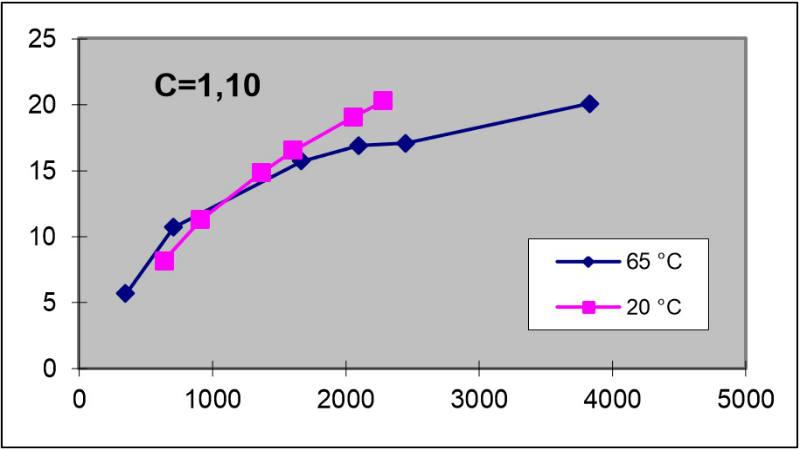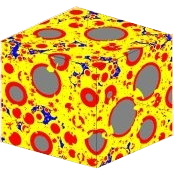
Çimento C Değeri Hesaplaması

BETON OLGUNLUK MERKEZİ
TANIMLAR

DETERMINATION OF THE C-VALUE PRINCIPLE :
- Make ten cubes or six morter prisms.
- Let five cubes or three prisms cure at different temperatures.
- Determine the compressive strength of the specimens after different curing times.
- Calculate the corresponding maturity for different C-Values.
- Select the C-value, for the most valid: same maturity = same compressive strength.
PROCEDURE WITH CUBES :
- Make a concrete mixture with hard compact aggregates and with the binding agent of which the C-value shall be determined. The water-binding agent factor shall be 0.50 ± 0.02.
- Fill ten moulds of 150 mm x 150 mm x 150 mm with this mixture.
- Place the cubes including the moulds immediately after making in a thermostatic bath:5 cubes at 20 ± 2 °C and 5 cubes at 65 ± 3 °C.
- Take measures to prevent the leaching of material that has not yet cured.
- Prevent as far as possible the test specimens of drying out and cooling during and after stripping.
- Record the time at the moment of placing.
- Record the temperature in the heart of at least one cube per thermostatic bath. At least three temperature measurements per hour shall be carried out.
- Transport the cubes from the thermostatic bath to the pressure bench in water with a temperature that is equal tot the temperature of the thermostatic bath.
- Determine the compressive strength immediately after removing from the water.
- Make sure that the compressive strength is evenly distributed over the strength range. For the binding agents in strength classes 32.5 (N and R) and 42.5N the range is 5 – 25 N/mm2 and fort he strength classes 42.5R and 52.5 (N and R) the range is 15 – 35 N/mm2. Make sure that at least two results are below and at least two results are above the middle value of the strength range.
- Calculate for a potential C-value the weighted maturity based on the measured hardening time and concrete temperature.
- Plot all results, these of 20°C and 65°C, in a graph against the compressive strength. On the x-axis, on a logarithmic scale, the maturity and on the y-axis, on a linear scale, the compressive strength shall be shown.
- Calculate the correlation coefficient of the regression line through the ten points.
- Repeat the calculations for other C-values.
- The C-value to be used is the value with the highest correlation coefficient.
- The C-value shall be rounded to 0.05.
PROCEDURE WITH MORTEL PRISMS :
- Make a mixture with the binding agent of which the C-value shall be determined. The water-binding agent factor shall be 0.50 ± 0.02.
- Fill six moulds of 40 mm x 40 mm x 160 mm with this mixture.
- Place the prisms including the moulds immediately after making in a thermostatic bath: 3 prisms at 20 ± 2 °C and 3 prisms at 65 ± 3 °C.
- Record the time at the moment of placing.
- Take measures to prevent the leaching of material that has not yet cured.
- Record the temperature in the heart of at least one prism per thermostatic bath. At least three temperature measurements per hour shall be carried out.
- Break immediately after stripping into two halves of a length of approximately 80 mm each.
- Prevent as far as possible the test specimens of drying out and cooling during and after stripping.
- Continue as described in „Procedure with Cubes“.
EQUIPMENT AND DEVICES :
- A thermostatic bath 20 ± 2 °C and a thermostatic bath 65 ± 3 °C.
- Thermocouple wires, with corresponding recording equipment.
CHECK :
- The initial determination of the C-value shall be determinated in triplicate, each on a separated batch of the binding agent. The median, rounded to 0.05 is the final C-value.
- A single check of the C-value shall be carried out at least once a year.
- The median of the three most recent determinations is the final C-value.
- If the difference between the highest and lowest value of the series of three is greater than 0.15 a new initial determination shall be carried out.
MIXING OF TWO BINDING AGENTS :
- When mixing two binding agents with an equal C-value this C-value also applies the mixture.
- When replacing not more than 5% of a binding agent the C-value still applies
- When mixing two binding agents with a difference between the C-values of 0.20 or less a linear interpolation may be carried out.
- When mixing two binding agents with a difference between the C-values of more than 0.20 the C-value shall be determinated for the binding agent mixture.
REPORT : A report must contain all important information and the graph for the relevant C-value must be reproduced.
